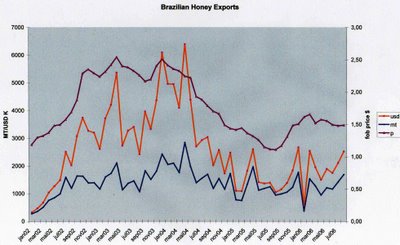Notícias e Oportunidades de Negócios
Informações, links, artigos e releases. Editado pela Laurino e Lopez Consultores Associados Ltda (UNIT BRAZIL). Website www.laurino-lopez.com.br
10/03/2006
FDL - Honey Market Report SEP 2006

Why has Chinese honey become of less interest to the U.K. and European markets?
The 2006 Chinese crop has been the worst in the last 15 years, and prices have continued to strengthen. Historically, Chinese honey has only been considered to be attractive if the price differential with Argentine honey is sufficiently wide (say around $ 300-$400/mt). Despite rising prices in Argentina, the differential between the two origins is now too narrow to be of interest to buyers.
In our earlier reports, we mentioned that the early Chinese crops - lighter grades of polyflora (max 25mm/34mm) and Acacia - were badly affected by cold and wet weather conditions. The ELA and LA crops are only now starting to be harvested, but the relevant provinces (Inner Mongolia, Jilin and Heilongjiang) continue to suffer from drought conditions and, thus, we are only expecting small crops. The sunflower crop (an important component part of ELA and especially LA polyflora honey) has only this week started to be harvested, and in reality we need more time to be definitive about the size and quality of the crop. In total, we anticipate a northern Chinese crop of about 10,000 mt, roughly 25% below normal. These factors alone are making for higher prices.
The poor 2006 spring crop has directly resulted in U.S. and Japanese demand (which together amount to between 60,000 and 70,000 mt per annum) not being fully satisfied and this unfulfilled demand has needed to be taken from the 2006 Summer crop availability, thereby forcing prices further upwards. As a comparison, E.U. demand is not such a major factor, largely attributable to ever-increasing analytical demands. The following statistics may be of some interest:
(a) Chinese exports 2001-2005
Year Total exports Exports to U.K. Exports to Japan Exports to U.S.A. Percentage of total exports shipped
mt mt mt mt to Japan and U.S.A.
2001 106,666 10,541 37,688 15,977 50.31%
2002 76,450 0 47,565 7,614 72.18%
2003 84,088 0 35,387 24,614 71.35%
2004 81,325 0 38,323 25,954 79.04%
2005 87,629 1,233 41,397 28,265 79.50%
It seems that the Europe and U.K. has been sidelined in the Chinese honey trade!
(b) Chinese exports January - May 2006
USA 15,511 mt at average price of $ 938/mt FOB. (January-May 2005: 12,046 mt)
Japan 8,893 mt at average price of $ 1,017/mt FOB. (January-May 2005: 9,081 mt)
Spain 1,008 mt at average price of $ 1,008/mt FOB. (January-May 2005: 724 mt)
UK 484 mt at average price of $ 975/mt FOB. (January-May 2005: 422 mt)
Germany 403 mt at average price of $ 970/mt FOB. (January-May 2005: 260 mt)
The following crude figures are particularly telling:
2001: China exported 107,000 mt, of which 42,000 mt was shipped to the E.U.
2005: China exported 86,000 mt, of which 6,600 mt was shipped to the E.U.
Table (b) shows the extent to which demand for Chinese honey from U.S.A. and Japan has increased, whereas shipments to the E.U. (and particularly the U.K., have declined. Much of the decline in demand from the U.K. is attributable to the heavy cost of analysis now required (although it should be clearly stated that such parameters as fluoroquinolones are ignored in most E.U. destinations, but not in the U.K.) The extra analysis has, naturally, resulted in less availability of Chinese honey, given the undeniable fact that the more one analyses the more one discovers....
There are two further factors that should be mentioned in respect of the increasing cost of Chinese honey: firstly, and the more important of the two, is the inexorable increase in domestic demand for bottled honey. A regulation was passed in China in march 2006 to ensure that domestically sold bottled honey should be more-or-less of export grade, particularly in respect of C13 analysis, and this has resulted in an estimated 60,000 mt annual demand coming into the market for good quality honey. This domestic demand is expected to continue in line with the domestic demand for virtually every other raw and finished product. The second factor is the slow but certain rise in the Renmimbi, which has now been revalued by about 4% since the rate was set free.



